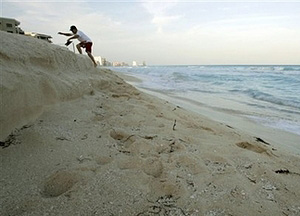 |
 |
 |
 Editorials | Environmental | March 2007 Editorials | Environmental | March 2007  
Cancun, Nature at War Over Beaches
 Julie Watson - Associated Press Julie Watson - Associated Press


| | A year after Mexico spent millions to replace its hurricane-devastated beaches, Cancun is fighting against Mother Nature once again: erosion is shrinking its sandy playground. Waves at high tide now lap against the decks of some new, glitzy hotels. (AP/Gregory Bull) |
It's very difficult to replicate the coast's natural dynamic. There's no way to know how it's going to react Cancun and Mother Nature are at war again.

Mexico spent $19 million to replace beaches washed away by Hurricane Wilma in 2005, but erosion has shrunk Cancun's sandy playground to the point where waves at high tide lap against some hotel patios.

To bring tourists pouring back after Hurricane Wilma, the ocean floor was dredged to rebuild eight miles of beach, nearly double their pre-hurricane size, and hotels were refurbished.

Just a year after the grand refurbishment was completed, the beaches have shrunk again, from 100 feet to less than 70 feet at mid-tide in the tourist zone, and swimmers are forced to clamber down 3-foot drops in the sand level to reach the water.

Most sections of beach remain about as wide as before the hurricane hit, although some are less _ barely 30 feet wide _ and the sea is relentlessly munching away at what's left, said biologist Alfredo Arellano, Yucatan director for the government's Commission for Natural Protected Areas.

Officials, developers and investors foresaw erosion and are preparing for a long-term response. They plan a public-private fund for future beach restorations, and an artificial reef to help contain the sand. Meanwhile, sandbags line some beaches and large, cloth-like tubes have been installed offshore.

But environmentalists see no point as long as hotels continue building at the water's edge and ripping out vegetation whose roots once helped to hold the sand in place. They are lobbying for a belt of native plants and walking paths, to separate hotels from beaches, even in places already developed.

'The type of construction that is going on is causing the beaches to erode at a much faster pace,' said Patricio Martin, director of the Quintana Roo chapter of the Mexican Center for Environmental Rights.

Cancun has experienced a building boom since Wilma washed away beach and exposed rocks.

Hotel owners responded by giving Cancun its biggest makeover yet _ a high-speed, $1.5 billion effort that brought the area back to No. 2 on this year's list of top spring break destinations, after slipping to No. 8 last year.

The Cancun Convention & Visitors Bureau says beaches typically erode in winter, when wind and currents are strongest, and that the shore returns to normal the rest of the year.

Environmentalists, however, say erosion has worsened ever since the 1970s, when the Mexican government began converting the long sandbar with coconut farms into the nation's top resort.

Developers blocked the barrier island's natural channels linking the sea to the lagoon on its inland side. The result: Currents that once flowed gently in and out now slam into the land and suck the sand back out into the sea.

'It's very difficult to replicate the coast's natural dynamic. There's no way to know how it's going to react,' Martin said.

Nevertheless, tourists seem pleased with the Cancun they see today. While students still flock to wet-T-shirt contests, booze cruises and get-naked-in-public events, the Caribbean city has changed dramatically into a more sophisticated resort of swanky spa hotels that attract couples and families.

'Every palm tree is new,' said Antonio Pitta, Latin America director for Cheaptickets.com and Orbitz.com. 'It's a brand new product.'

Janet Ricciuti, 47, a funeral service executive from Victoria, British Colombia, said the sand is a little brown and there are more shells and kelp than in the past.

'But it's still lovely,' said Ricciuti, enjoying the blazing sun as the turquoise waters washed at her feet. 'Anything is better than the rain' back home. | 
 | |
 |



